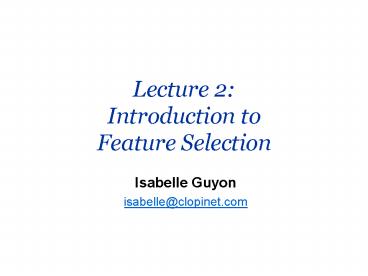Lecture 2: Introduction to Feature Selection - PowerPoint PPT Presentation
1 / 32
Title:
Lecture 2: Introduction to Feature Selection
Description:
Talk.politics.mideast: israel, armenian, turkish. Talk.religion.misc: jesus, god, jehovah ... Reuters: 21578 news wire, 114 semantic categories. 20 newsgroups: ... – PowerPoint PPT presentation
Number of Views:65
Avg rating:3.0/5.0
Title: Lecture 2: Introduction to Feature Selection
1
Lecture 2Introduction toFeature Selection
- Isabelle Guyon
- isabelle_at_clopinet.com
2
Notations and Examples
3
Feature Selection
- Thousands to millions of low level features
select the most relevant one to build better,
faster, and easier to understand learning
machines.
n
n
X
m
4
Leukemia Diagnosis
n
-1
1
m
1
-1
yi, i1m
-yi
Golub et al, Science Vol 28615 Oct. 1999
5
Prostate Cancer Genes
HOXC8
G4
G3
BPH
RACH1
U29589
RFE SVM, Guyon-Weston, 2000. US patent
7,117,188 Application to prostate cancer.
Elisseeff-Weston, 2001
6
RFE SVM for cancer diagnosis
Differenciation of 14 tumors. Ramaswamy et al,
PNAS, 2001
7
QSAR Drug Screening
- Binding to Thrombin
- (DuPont Pharmaceuticals)
- 2543 compounds tested for their ability to bind
to a target site on thrombin, a key receptor in
blood clotting 192 active (bind well) the
rest inactive. Training set (1909 compounds)
more depleted in active compounds. - 139,351 binary features, which describe
three-dimensional properties of the molecule.
Number of features
Weston et al, Bioinformatics, 2002
8
Text Filtering
Reuters 21578 news wire, 114 semantic
categories. 20 newsgroups 19997 articles, 20
categories. WebKB 8282 web pages, 7
categories. Bag-of-words gt100000 features.
- Top 3 words of some categories
- Alt.atheism atheism, atheists, morality
- Comp.graphics image, jpeg, graphics
- Sci.space space, nasa, orbit
- Soc.religion.christian god, church, sin
- Talk.politics.mideast israel, armenian, turkish
- Talk.religion.misc jesus, god, jehovah
Bekkerman et al, JMLR, 2003
9
Face Recognition
- Male/female classification
- 1450 images (1000 train, 450 test), 5100 features
(images 60x85 pixels)
Navot-Bachrach-Tishby, ICML 2004
10
Nomenclature
- Univariate method considers one variable
(feature) at a time. - Multivariate method considers subsets of
variables (features) together. - Filter method ranks features or feature subsets
independently of the predictor (classifier). - Wrapper method uses a classifier to assess
features or feature subsets.
11
Univariate Filter Methods
12
Individual Feature Irrelevance
- P(Xi, Y) P(Xi) P(Y)
- P(Xi Y) P(Xi)
- P(Xi Y1) P(Xi Y-1)
Legend Y1 Y-1
density
xi
13
Individual Feature Relevance
m-
m
-1
s-
s
xi
14
S2N
m-
m
-1
S2N ? R x ? y after standardization x
?(x-mx)/sx
s-
s
15
Univariate Dependence
- Independence
- P(X, Y) P(X) P(Y)
- Measure of dependence
- MI(X, Y) ? P(X,Y) log dX dY
- KL( P(X,Y) P(X)P(Y) )
P(X,Y) P(X)P(Y)
16
Correlation and MI
R0.02 MI1.03 nat
X
P(X)
X
Y
Y
P(Y)
R0.0002 MI1.65 nat
X
Y
17
Gaussian Distribution
X
P(X)
X
Y
Y
P(Y)
X
Y
MI(X, Y) -(1/2) log(1-R2)
18
Other criteria ( chap. 3)
19
T-test
m-
m
P(XiY1)
P(XiY-1)
-1
xi
s-
s
- Normally distributed classes, equal variance s2
unknown estimated from data as s2within. - Null hypothesis H0 m m-
- T statistic If H0 is true,
- t (m - m-)/(swithin?1/m1/m-)
Student(mm--2 d.f.)
20
Statistical tests ( chap. 2)
Null distribution
- H0 X and Y are independent.
- Relevance index ? test statistic.
- Pvalue ? false positive rate FPR nfp / nirr
- Multiple testing problem use Bonferroni
correction pval ? n pval - False discovery rate FDR nfp / nsc ? FPR
n/nsc - Probe method FPR ? nsp/np
21
Multivariate Methods
22
Univariate selection may fail
Guyon-Elisseeff, JMLR 2004 Springer 2006
23
Filters vs. Wrappers
- Main goal rank subsets of useful features.
- Danger of over-fitting with intensive search!
24
Search Strategies ( chap. 4)
- Forward selection or backward elimination.
- Beam search keep k best path at each step.
- GSFS generalized sequential forward selection
when (n-k) features are left try all subsets of g
features i.e. ( ) trainings. More trainings at
each step, but fewer steps. - PTA(l,r) plus l , take away r at each step,
run SFS l times then SBS r times. - Floating search (SFFS and SBFS) One step of SFS
(resp. SBS), then SBS (resp. SFS) as long as we
find better subsets than those of the same size
obtained so far. Any time, if a better subset of
the same size was already found, switch abruptly.
n-k
g
25
Multivariate FS is complex
Kohavi-John, 1997
N features, 2N possible feature subsets!
26
Embedded methods
All features
Yes, stop!
No, continue
Recursive Feature Elimination (RFE) SVM.
Guyon-Weston, 2000. US patent 7,117,188
27
Embedded methods
All features
Yes, stop!
No, continue
Recursive Feature Elimination (RFE) SVM.
Guyon-Weston, 2000. US patent 7,117,188
28
Feature subset assessment
N variables/features
Split data into 3 sets training, validation, and
test set.
- 1) For each feature subset, train predictor on
training data. - 2) Select the feature subset, which performs best
on validation data. - Repeat and average if you want to reduce variance
(cross-validation). - 3) Test on test data.
M samples
29
Complexity of Feature Selection
With high probability
Generalization_error ? Validation_error e(C/m2)
Error
m2 number of validation examples, N total
number of features, n feature subset size.
n
Try to keep C of the order of m2.
30
Examples of FS algorithms
keep C O(m2)
keep C O(m1)
31
In practice
- No method is universally better
- wide variety of types of variables, data
distributions, learning machines, and objectives.
- Match the method complexity to the ratio M/N
- univariate feature selection may work better than
multivariate feature selection non-linear
classifiers are not always better. - Feature selection is not always necessary to
achieve good performance.
NIPS 2003 and WCCI 2006 challenges
http//clopinet.com/challenges
32
Book of the NIPS 2003 challenge
Feature Extraction, Foundations and
Applications I. Guyon et al, Eds. Springer,
2006. http//clopinet.com/fextract-book































